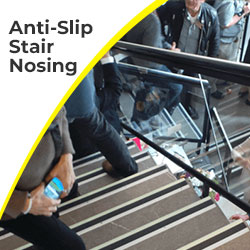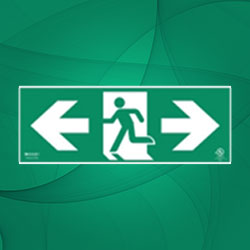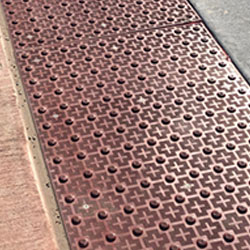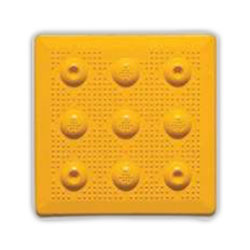






























































































"Together, truncated domes and guidance bars act as 'eyes guiding the visionless' creating a safe, navigable and inclusive built environment for all."
Tactile walking surface indicators (TWSI) like truncated domes and wayfinding bars are indispensable accessibility features that work hand in hand to enhance safety, navigation, and mobility for visually impaired citizens as well as the aging population across Canada. As per the Accessibility for Ontarians with Disabilities Act (AODA), the National Building Code of Canada (NBC), and other regional codes, the installation of these detectable surfaces is mandatory in certain areas. But how exactly do these tactile cues function synergistically to aid smooth, unrestricted mobility? Let's delve deeper.
Over the decades, these tactile surfaces have witnessed revolutionary advancements that not only strengthened their inherent abilities but also brought them in perfect concordance for users' benefit. What began as simple textured blocks inspired by Braille morphed into smart solutions leveraging cutting-edge materials and digital technologies. Some key milestones that advanced their compatible designs include:
• The genesis of tactile paving in 1965 Japan marked truncated domes' debut as standalone warning cues at hazards. Soon, detectable bars appeared to guide pedestrian paths through complex urban scapes (1970s).
• Standardization efforts via ISO and codes established uniform meanings, sizes, and placement patterns, ensuring consistent multilingual comprehension globally.
• New slip-resistant composites like polymers and metals facilitated outdoor deployments with unparalleled durability against freeze-thaw cycles.
• Distinct profile variations differentiated the purposes of domes, denoting 'Caution' from elongated 'Follow this way' bars accordingly.
• Digital upgrades allow conducting location data and audible maps to augment traditional tactile wayfinding for optimum accessibility.
The key to truncated domes and guidance bars' success lies in their thoughtfully complementary functions that work in perfect harmony. Some examples:
• Domes placed at curb ramp transitions, stairs, and platform edges alert users of potential hazards requiring evaluation through distinct grid-like textures.
• Bars installed ahead guide pedestrians safely to cross roads or board transit following continuous parallel ribs' direction.
• The experience of first encountering domes cues users to switch to an exploratory cautionary mode before proceeding under the bars' intuitive guidance.
• Color contrasts like tactile yellow for domes against other contrasting bars aids instant visual identification at a glance.
• Placements see domes bookending walkways that continue within using bars, thus complementing each other's roles seamlessly.
So in essence, while domes signal potential danger upcoming, bars orient users along designated accessible routes through decision points marked by domes - a perfect illustration of 'obstacles avoided, destination achieved' working together.
As Tactile Solution Canada's business caters to unique indoor and outdoor tactile needs, understanding the specific challenges and code mandates indoors is crucial. Some noteworthy points:
• National Building Code of Canada and AODA require TWSI at stairs, escalators, elevators and certain areas for wayfinding within premises open to public.
• For high contact areas like arenas and malls, only heavy-duty certified materials ensuring longevity under relentless daily footfall are recommended.
• Solutions must be rigorously tested and certified by agencies like CSA to meet all relevant standards for properties like slip-resistance, dimensional stability, weather resistance, etc.
• Fire-resistant models like AccessTile's Surface Applied Tactile compositely bond to diverse substrates, simplifying retrofits.
• Advantage's self-adhesive single domes and bars are easily DIY installed for floor-to-ceiling accessibility upgrades and renovations.
• EonTile's versatility lets durable rubber tiles seamlessly upgrade any indoor flooring surface while complementing interior design aesthetics.
• Ecoglo's photoluminescent products provide dual-benefit of emergency illumination and guidance as mandated by codes.
By adhering to all code guidelines for material certification, product sizes, and compliant placement patterns, these solutions deliver optimal indoor wayfinding experiences.
When installed tactfully in pre-determined yet creative patterns, truncated domes and guidance bars together can facilitate intuitive orientation like none other. Some such effective combinations include:
• Grids of domes at entry transitions that branch into linear bars denoting pathways and cross corridors.
• Circular dome arcs with radial bars emanating at intervals for easy circular walking within open areas.
• Sequential columns of single domes placed between parallel dual bars to demarcate lengthy corridors.
• Intermittent single domes inserted along single directional bars to reaffirm orientation periodically.
• Distinct parallel double bars bordering walkways for clear demarcation from other functional surfaces.
Apart from compliant placements, choosing reliable materials proven to withstand high contact is equally important for combinations' longevity. Tactile Solution providers like us employ only rigorously tested premium options for safety-critical applications.
In a nutshell, tactile walking surface indicators perform at their best when installed judiciously in pre-determined yet creative combinations. By understanding their distinct but complementary roles through the lens of evolution and codes, architects, designers, and contractors can now effortlessly incorporate compliant yet ingenious tactile patterns, enhancing universal accessibility, safety, and experience for communities. Tactile Solution Canada remains your one-stop destination offering an exhaustive catalogue of AODA compliant indoor and outdoor solutions that work in perfect concordance.
1. What are the key differences between truncated domes and guidance bars?
Truncated domes are raised bumps used as warning cues to indicate hazards or potential dangers ahead. Guidance bars feature elongated flat ridges that run parallel to indicate the direction of accessible paths. While domes signal "caution," bars provide intuitive wayfinding.
2. Which codes mandate the installation of tactile surfaces?
The key codes requiring tactile surfaces include the Accessibility for Ontarians with Disabilities Act (AODA), National Building Code of Canada (NBC), and regional municipality standards. They specify placement locations and material performance criteria for tactile products to comply.
3. Which areas indoors require tactile solutions?
As per NBC and AODA, code-compliant tactiles must be installed at stairs, escalators, elevators, and certain indoor areas for wayfinding within facilities open to public use like malls, arenas, institutional buildings, etc.
4. How can existing indoor floors be tactilely upgraded?
Many compliant tactile systems are specially engineered to securely bond to a wide variety of indoor flooring substrates. Fire-resistant and self-adhesive models facilitate seamless accessibility retrofits with minimal disruptions.
5. What patterns are considered for tactile combinations?
Strategic patterns like grids, circles, linear columns, and intermittent inserts tactfully combine truncated domes and guidance bars. They facilitate intuitive navigation through decision points for the vision impaired within buildings and public spaces.
